Femia > Health Library > Getting Pregnant > Planning pregnancy > How long does it take to get pregnant after IUD removal?
How long does it take to get pregnant after IUD removal?
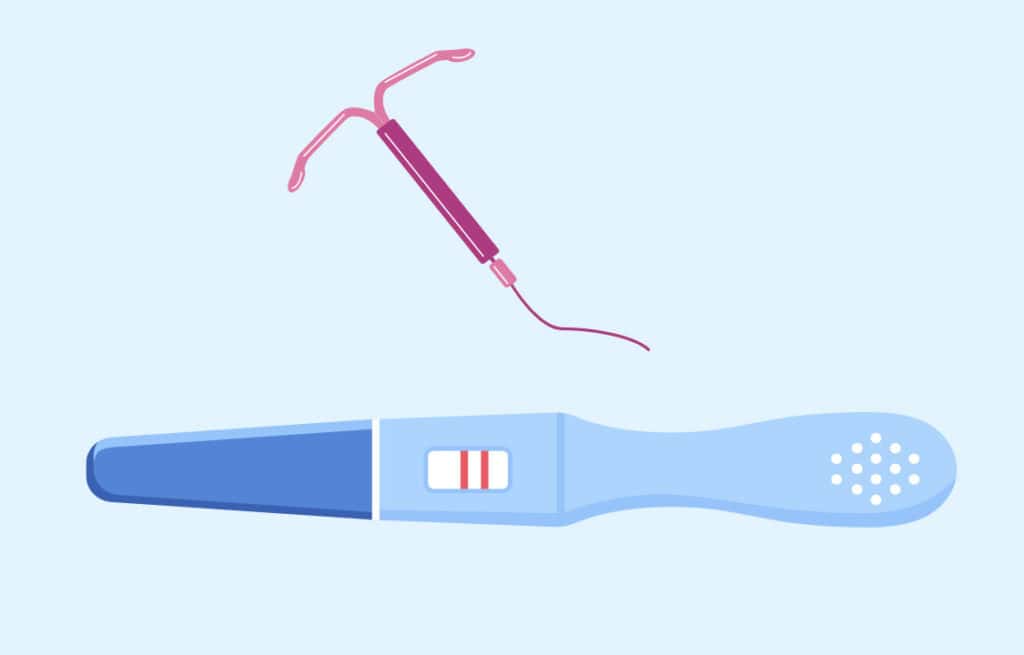
- Updated Feb 10, 2025
- Published
CRAFTED BY HUMAN
Crafted by human At Femia, we provide accurate and up-to-date information at every stage of your journey, from trying to conceive, pregnancy and postnatal support. All content is created by a real person based on in-depth research and own professional experience. Femia ensures that you will receive expert advice, strict accuracy and a personalized approach from our authors/medical experts. Learn more about our editorial policy.
FACT CHECKED
Fact checked At Femia Health, we maintain the highest standards of editorial excellence in delivering content focused on helping you conceive, guiding you through pregnancy, and supporting you postpartum. Explore our content review principles to learn how we ensure the accuracy and quality of our health and lifestyle tips for every stage of your journey.
There are two main types of IUDs: hormonal (levonorgestrel) and copper. They function differently in how they prevent pregnancy. Usually, as soon as you remove the IUD, you can get pregnant within one month or even earlier. However, as every body is different, the timeline to get pregnant can vary. It depends on factors like age, fertility, and the overall health of both partners.
An IUD is commonly considered the most effective, safe, and reversible method to prevent conception or pregnancy when you are not ready for a baby, according to the American College of Obstetricians and Gynecologists.
If you want to get pregnant and are planning for IUD removal, or have removed your IUD already and want to know how soon you might conceive, we’ve got you covered.
Femia offers the most accurate tool for determining ovulation and fertile days
The process of IUD removal
IUD removal is a simple, typically quick procedure performed by a healthcare provider. During the removal, the provider gently pulls on the IUD strings, guiding the device out of the cervix and uterus. Most women experience only mild discomfort or cramping, which usually subsides shortly after the procedure.
For those with hormonal IUDs, removal may cause hormonal changes as the body readjusts, and some people might notice shifts in their menstrual cycle or symptoms such as mood changes, cramping, or spotting. Fertility can return quickly after IUD removal, often within a month, making it a convenient option for those planning to conceive.
How long does it take to get pregnant after IUD removal?
An intrauterine device (IUD) acts as a barrier that prevents sperm from reaching the egg, but it typically doesn’t inhibit ovulation. This means that once the IUD is removed, the barrier is gone, and conception can occur fairly quickly. Here’s what to consider:
- Immediate fertility return: Pregnancy is possible soon after IUD removal since ovulation usually resumes promptly.
- Hormonal IUDs and menstrual cycle: It may take around a month for your cycle to normalize, particularly if you used a hormonal IUD.
- Average pregnancy timeline: Studies indicate that around 80-85% of women conceive within a year after IUD removal, with many achieving pregnancy even earlier.
Factors impacting time to pregnancy:
- Age: Fertility tends to decline with age, making conception more challenging for some older women.
- Overall health: Conditions like PCOS, endometriosis, or lifestyle factors (diet, stress) can affect fertility.
- Type of IUD used: Hormonal IUDs may delay cycle regularity slightly compared to copper IUDs.
Finally, it’s recommended to have a healthcare checkup after IUD removal to ensure there are no other factors affecting your fertility.
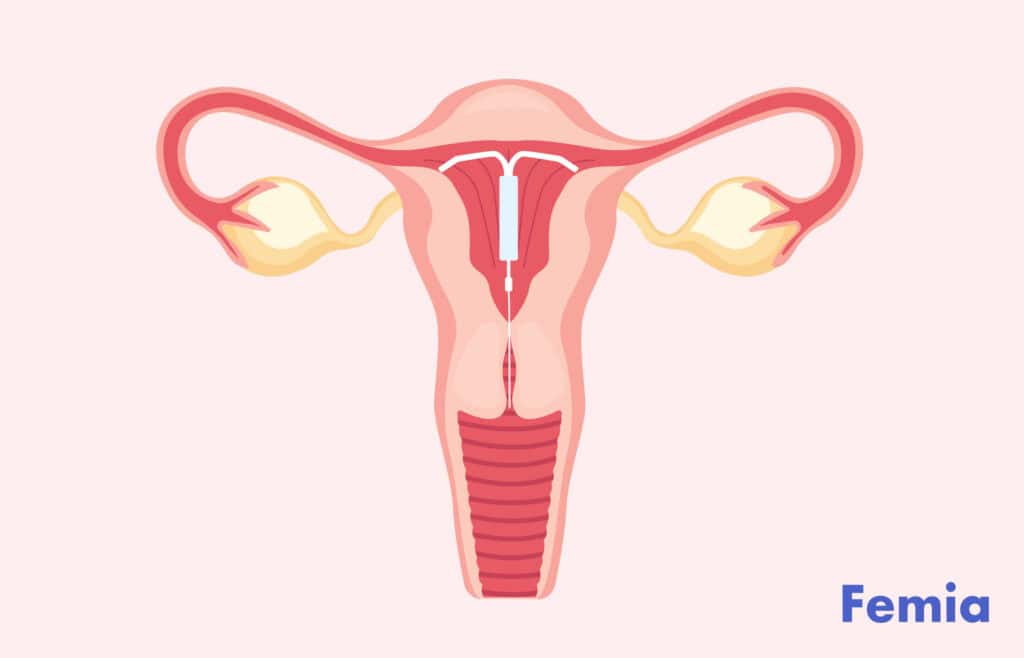
Early signs of pregnancy after IUD removal
Here are some early signs of pregnancy you may notice shortly after IUD removal:
- Missed period: One of the first signs, though menstrual irregularities can also occur post-IUD removal.
- Breast tenderness: Hormonal changes can cause breasts to feel sore or swollen.
- Mild cramping: Light cramping can occur as the fertilized egg implants in the uterine lining.
- Fatigue: Increased tiredness is common due to rising progesterone levels in early pregnancy.
- Nausea and sensitivity to smells: Some women experience morning sickness or aversions to certain scents.
- Light spotting: Known as implantation bleeding, this can happen when the embryo attaches to the uterus.
If you experience any of these symptoms, taking a pregnancy test can help confirm if conception has occurred.
Factors affecting fertility after IUD removal
Some factors may affect how fertile you are after IUD removal, including:
- Types of IUDs used
- Duration of using IUD
- Your overall reproductive health
- Your age
1. Types of IUD
There are two main types of IUDs:
- Hormonal IUD
- Copper IUD
Hormonal IUD
A hormonal IUD, sold under the brand names of Mirena, Skyla, and Kyleena is a small plastic device that is inserted through the vagina, passes the cervix, and reaches the uterus.
The device releases a hormone called progestogene into your uterus. This hormone thins the endometrial lining and also thickens the cervical mucus, making it harder for the sperm to reach the egg for implantation.
The hormonal IUDs has been shown to affect ovulation to some extent within the first year of placement, but thereafter, most cycles become ovulatory. One study indicated that the incidence of ovulatory cycles with Mirena and the copper IUD was similar at 85%.
After you remove the hormonal IUD, your body may take some time to resume fertility, as your uterus recovers from the hormonal effects of progestogen.
Some women may get pregnant immediately after hormonal IUD removal, while some may take time and conceive when their ovulation returns to normal and the hormonal effects subside.
Copper IUD
A copper or non-hormonal copper IUD, sold under the brand name of Paragard, is a small device that releases minimal amounts of copper into the uterus, interfering with sperm movement and preventing a successful implantation.
As copper creates a toxic environment for sperm, it prevents implantation. this type of IUD, there are no hormonal effects, so fertility may occur as soon as you remove the copper IUD or within a few weeks, and generally doesn’t require much time.
2. Duration of IUD use
Most studies show that the duration of IUD use doesn’t affect how quickly fertility returns. Hence, you can get pregnant immediately after removing the IUD, regardless of the duration of use.
That said, the timeline varies for each individual. Some can get pregnant immediately, while some may take up to a year, and both situations are normal.
3. Overall reproductive health
Your overall reproductive health has a significant impact on fertility after IUD removal.
If you have conditions like PCOS or endometriosis, these can make it harder to get pregnant. It’s important to understand that these conditions are not caused by the IUD or its removal. They affect your reproductive system on their own.
For example, with PCOS, the follicles containing the egg in your ovaries do not grow and mature; hence, they are unable to proceed to ovulation.
Endometriosis is another reproductive disease that causes the tissue that is similar to the lining of the uterus to grow outside of the uterus.
While some women may conceive with endometriosis and PCOS, it is recommended to seek treatment for reproductive diseases to increase the chances of a healthy pregnancy and improve fertility outcomes after IUD removal.
4. Age
Age is another factor that may impact the time to conceive.
While studies indicate that there is no significant correlation between fertility and age of IUD removal, women older than 30 years may take slightly longer to conceive than younger women.
In other words, while getting pregnant may take longer as you get older, having an IUD is not known to compound this problem.
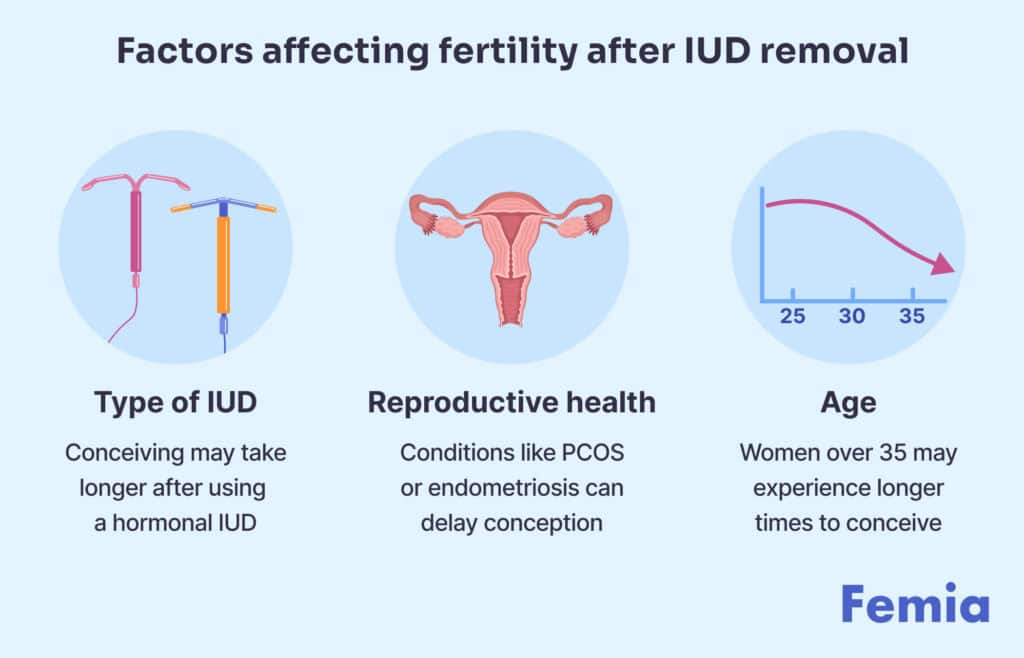
Trouble getting pregnant after an IUD
If you’re experiencing difficulty conceiving after IUD removal, here are some possible reasons for delays or issues:
- Hormonal imbalance: For those who used hormonal IUDs, it may take a month or more for the menstrual cycle to normalize.
- Age-related fertility decline: Fertility naturally decreases with age, particularly after age 35, which can affect conception time.
- Underlying health conditions: Conditions like polycystic ovary syndrome (PCOS), endometriosis, or thyroid issues can impact fertility.
- Uterine lining recovery: Some women may need time for the uterine lining to fully recover after long-term IUD use, especially if the IUD caused thinning.
- Stress and lifestyle factors: High stress, poor diet, and lack of exercise can contribute to hormonal imbalances, impacting fertility.
- Residual inflammation or scarring: Although rare, some women may experience mild uterine inflammation or scarring after IUD removal, which can affect implantation.
If difficulties persist, consulting with a healthcare provider can help identify and address any underlying issues affecting conception.
If you wish to avoid pregnancy —find the right contraception
Here are some effective contraception options to consider:
Birth control pills: Taken daily, these pills regulate hormones to prevent ovulation and are highly effective when used consistently.
Intrauterine device (IUD): Both hormonal and copper IUDs are long-term options that provide protection for several years and are over 99% effective.
Contraceptive implant: A small rod inserted under the skin releases hormones to prevent ovulation, offering up to 3 years of protection.
Contraceptive injection: The shot is administered every three months and is a convenient option for those who prefer less frequent dosing.
Contraceptive patch or vaginal ring: These options release hormones similar to birth control pills and need to be replaced on a weekly or monthly basis, respectively.
Barrier methods: Options like condoms, diaphragms, and cervical caps physically block sperm from reaching the egg and are effective when used correctly, often combined with spermicide.
Permanent solutions: Tubal ligation or vasectomy are surgical procedures for those who are certain they don’t want future pregnancies.
It’s best to discuss these options with a healthcare provider to find the contraception that aligns with your health needs and lifestyle preferences.
Why am I not getting pregnant after IUD removal?
Some reasons that can delay or interfere with conception after IUD removal include:
- Pre-existing reproductive diseases, like PCOS, endometriosis, uterine fibroids, or irregular ovulation cycles.
- A fertility decline due to increased age, i.e., above 30-35 years.
- Stress and lifestyle factors, like obesity, excessive alcohol or tobacco use.
If you are concerned about being able to conceive, it’s always safe to consult your doctor a month or two after IUD removal just to ensure everything is normal. If you are healthy and not getting pregnant more than six months after IUD removal, check with them again to find out any underlying cause of delay.
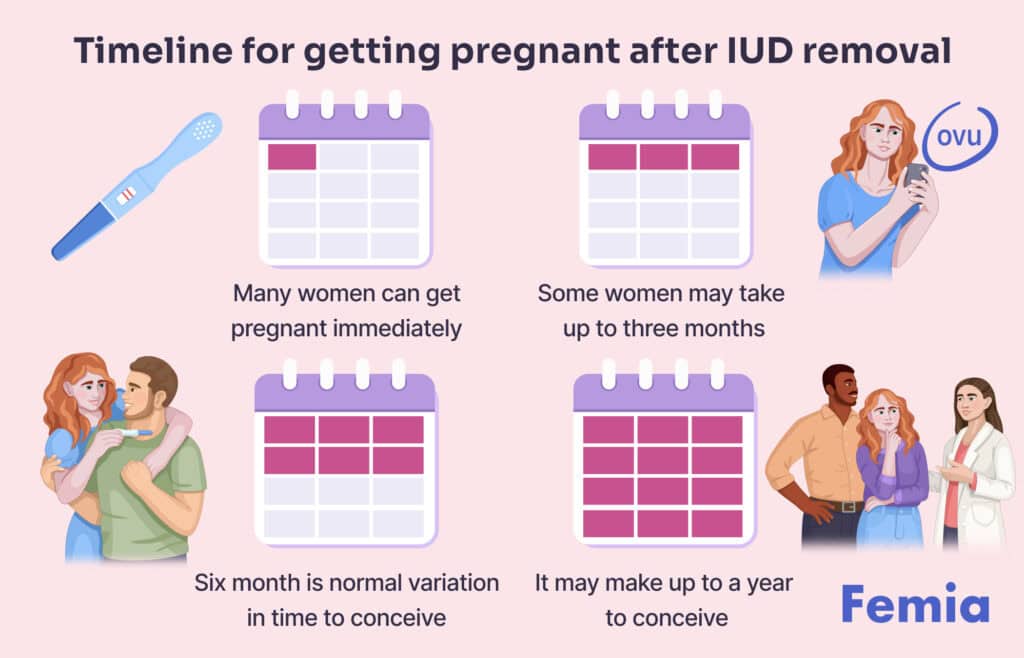
Tips for getting pregnant after IUD removal
Here are some tips that may help enhance fertility and increase the chances of conception once your IUD is out:
Track ovulation
Your chances of conceiving are highest during ovulation, so being able to estimate when this time is can increase the likelihood of pregnancy. There are various kits, ovulation trackers, and apps, like the Femia app, that can help you track your ovulation.
You can track your ovulation by the following methods:
- The easiest way to track ovulation is using the ovulation tracking app like the Femia app. A chatbot feature will help you monitor your ovulation symptoms, record period days, and provide guidance from medical professionals.
- You can also use ovulation predictor kits, similar to at-home pregnancy devices. They use your urine to check for the hormone that stimulates ovulation.
Femia offers the most accurate tool for determining ovulation and fertile days
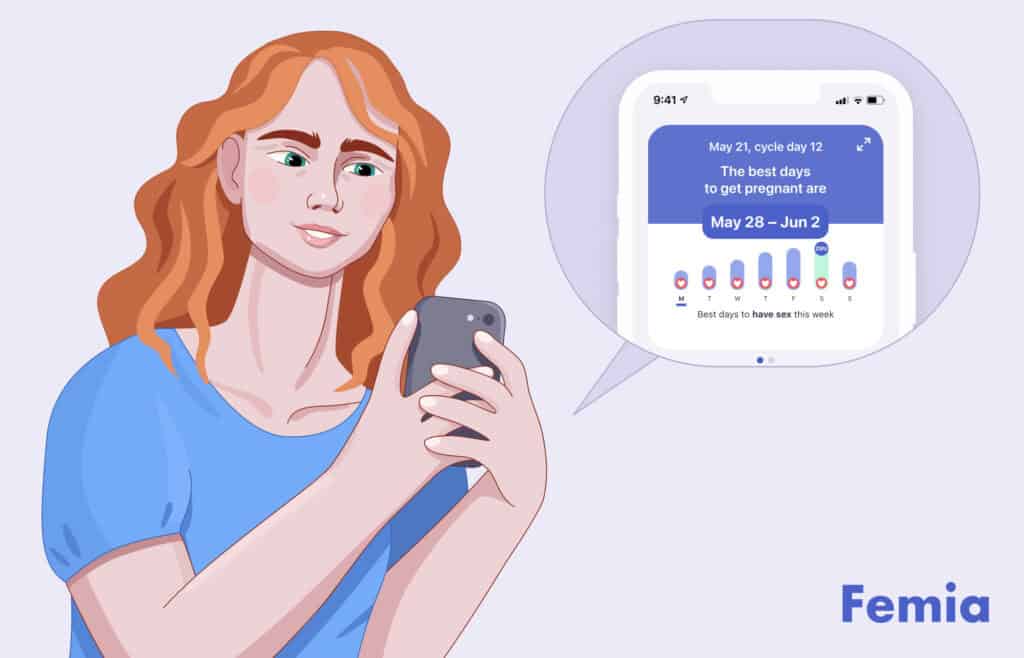
Maintain a healthy lifestyle
Having a healthy lifestyle is mandatory to increase your chances of fertility after IUD removal.
It is recommended to avoid excessive alcohol consumption, limit or avoid smoking, and opt for regular, 60-minute weekly moderate-intensity physical activity, like light jogging or brisk walking.
Moreover, it is crucial to manage stress. You can minimize stress in various natural ways, like deep breathing, taking breaks, doing things that you enjoy, sharing your feelings with a trusted friend or relative, and getting enough sleep. If you find that managing stress is challenging, consider reaching out to a mental health professional for additional support.
Physical activity is the great way to manage stress as it releases endorphins (the happy hormone) in your body. You can also divert your mind by going outdoors to places you enjoy.
Remember, staying relaxed as you wait and maintaining a healthy diet are essential elements to enhance fertility.
Consult your healthcare provider
If you have any other concerns regarding your fertility after IUD removal, it is recommended to consult with your healthcare provider for personalized advice and to check for any other underlying conditions that are delaying or preventing conception.
Questions from the Femia community
How long should I wait before trying to conceive after IUD removal?
It is okay to start trying to conceive immediately after IUD removal, there is no data behind not starting to conceive at any point after IUD removal.
Can the removal procedure itself affect my fertility?
IUD removal is even safer and easier than IUD insertion. Moreover, the removal procedure doesn't have any effect on fertility, and you can even conceive immediately after IUD removal.
However, if you face any complications while removing or after removing the IUD, like heavy or excessive bleeding, pain in the abdomen or uterus, or painful intercourse, it is important to consult your healthcare provider.
Can past IUD use increase the risk of ectopic pregnancy?
There's a less than 1% chance of becoming pregnant with an IUD in place, but if it happens, the risk of an ectopic pregnancy is higher. However, once the IUD is removed, the risk of an ectopic pregnancy goes back to being the same as for someone who has never used an IUD.
When reviewing the safety and effectiveness of IUCDs, it's found that hormonal IUCDs result in ectopic pregnancies in about 2 out of every 10,000 women per year, while copper IUCDs affect about 5 out of every 10,000 users annually. This translates to a very low percentage—0.02% and 0.05%, respectively. In comparison, the general incidence of ectopic pregnancy in the UK is approximately 1.25% (1 in 80 women).
While pregnancies with an IUCD in place are more likely to be ectopic, the overall likelihood of conception with an IUCD is significantly lower, thereby reducing the overall risk of ectopic pregnancy.
Is it normal to have irregular periods after IUD removal?
Yes, it's normal to experience spotting or irregular periods after IUD removal for some time. But, your menstrual cycle should normalize within a few months.
This is mainly because the hormones released in the hormonal IUD can make your uterus lining thinner, resulting in irregular periods or spotting, which may take a few months to normalize and build up.
Can the IUD affect my fertility long-term?
In most females, using an IUD doesn't have any long-term effects on fertility once removed. However, it is crucial that you maintain a healthy diet, weight, and lifestyle to enhance fertility after IUD removal.
The bottom line
While it is sometimes possible to conceive immediately after IUD removal, the timeline depends on several other factors as well. How long it takes to conceive can vary depending on a woman’s body physiology and factors like overall health, type of IUD used, and age. With these considerations in mind, it is also normal for it to take six months to a year to conceive after IUD removal.
The best practice for a couple is to consult their healthcare provider after IUD removal to reassure their fertility health.
References
- “Contraception – Intrauterine Devices (IUD).” Better Health Channel, www.betterhealth.vic.gov.au/health/healthyliving/contraception-intrauterine-devices-iud.
- Girum, Tadele, and Abebaw Wasie. “Return of Fertility After Discontinuation of Contraception: A Systematic Review and Meta-analysis.” Contraception and Reproductive Medicine, vol. 3, no. 1, July 2018, https://doi.org/10.1186/s40834-018-0064-y.
- “Long-Acting Reversible Contraception: Implants and Intrauterine Devices.” ACOG, www.acog.org/clinical/clinical-guidance/practice-bulletin/articles/2017/11/long-acting-reversible-contraception-implants-and-intrauterine-devices.
- “Return of Fertility in Various Types of IUD Users.” PubMed, 1 Apr. 1989, pubmed.ncbi.nlm.nih.gov/2565315.
- Andolsek, Lidja, et al. “Time to Conception After IUD Removal: Importance of Duration of Use, IUD Type, Pelvic Inflammatory Disease and Age.” International Journal of Gynaecology and Obstetrics, vol. 24, no. 3, June 1986, pp. 217–23. https://doi.org/10.1016/0020-7292(86)90100-1.
- “Our Fertility Doctors | Tennessee Reproductive Medicine.” Tennessee Reproductive Medicine, 16 Mar. 2023, trmbaby.com/about-us/doctors/?gad_source=1&gclid=Cj0KCQjw4MSzBhC8ARIsAPFOuyUmJve7X1EAVslAwQwzsJD7MfPPBRiJswD6bEVplIfrZeG842KvNuQaAs8DEALw_wcB.
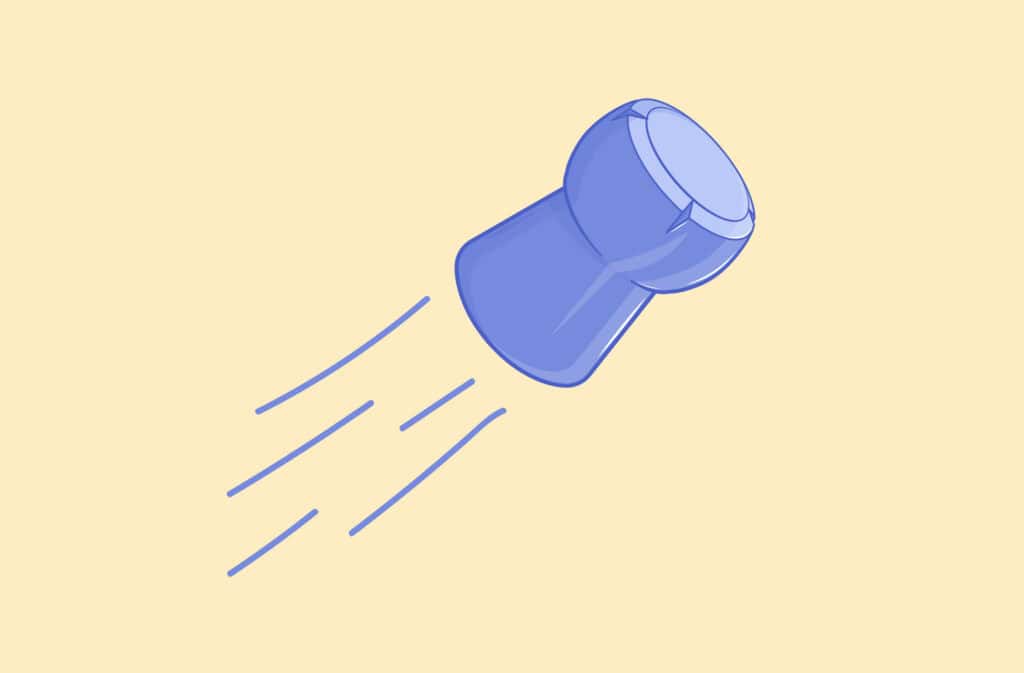
Discover things to avoid after losing mucus plug and what to do next. Learn how long after losing mucus plug labor starts and what happens to your body. Expert advice from Femia.
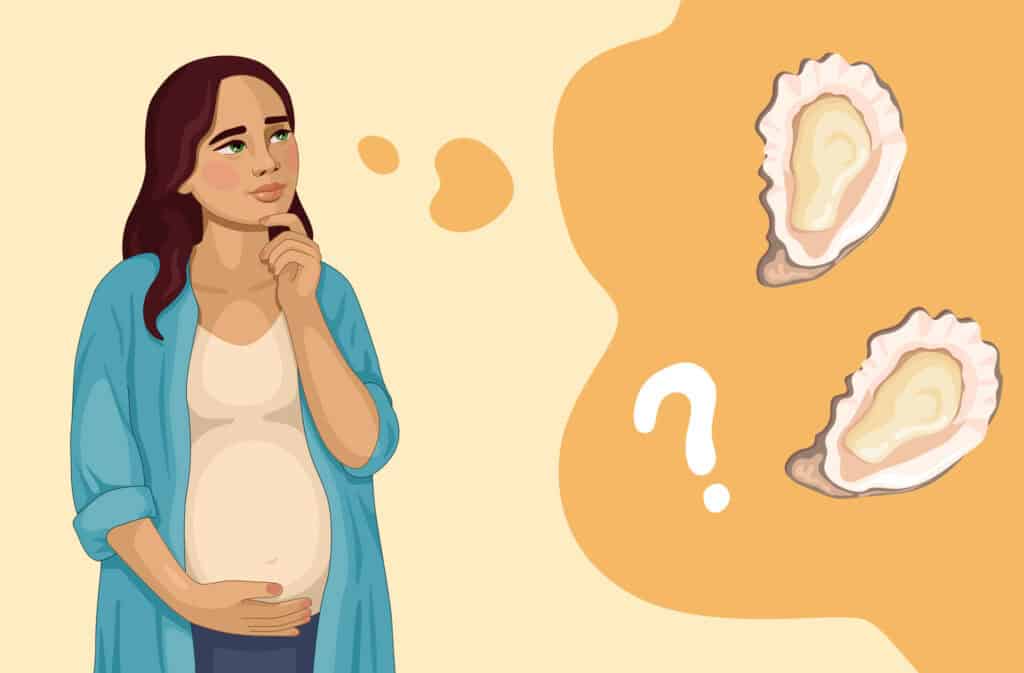
Wondering if can you eat oysters while pregnant? Follow through for the do’s and don’ts when it comes to consuming oysters during pregnancy.

Let’s learn what is postpartum hair loss, why it happens, and how you can manage the process.

